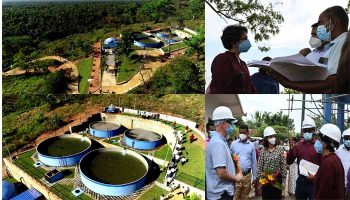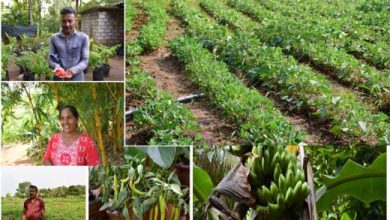Out of sight, but not out of mind

Groundwater: Why is it important?
Groundwater forms the invisible part and plays a key role in the hydrologic cycle. Although groundwater is invisible, its impact is visible everywhere. Humanity’s demand for water is growing. Pressure on water resources is increasing due to overuse, pollution and climate change. Droughts and heatwaves are becoming more intense and frequent. Sea-level rise is driving salt-water intrusion into coastal aquifers and groundwater aquifers are depleting.
Stored in rocks and soil, groundwater is our biggest source of liquid freshwater. It sustains drinking water supplies, sanitation systems, farming, industry and ecosystems. It is also critically important to the healthy functioning of ecosystems, such as wetlands and rivers.
Yet, some 20 per cent of the world’s aquifers are being overexploited, leading to land instability and subsidence, and, in coastal regions, to sea water intrusion under the land. As climate change gets worse, the need for groundwater will become more and more critical. Groundwater may be out of sight, but it must not be out of mind.
Quality and pollution
Groundwater faces mainly two potential threats to its quality; natural (geogenic) contamination and contaminant sources from land use and other human activities (anthropogenic).
Anthropogenic contamination includes the effects of agricultural intensification, urbanization, population growth and climate change. For example, across Africa, groundwater quality is affected by poor sanitation infrastructure and agriculture practices, which has led to high levels of nitrate and microbial contamination. Common reasons for groundwater quality deterioration also include changes to the groundwater environment and groundwater contamination from pollution sources.
Groundwater for Water Supply Schemes in Sri Lanka
The global importance as well as the threats to this resource are common in Sri Lanka too.
Since 1970, groundwater has been extracted for water supply schemes (WSS) that provide pipe-borne water to consumers in Sri Lanka. However, it is reported that groundwater is being over-used in many areas, where more water is abstracted from aquifers than is recharged by rain. Continuous over-use such as this eventually leads to depletion of the resource.
At present, more than 4000 rural, small town, and semi-urban water supply schemes use groundwater sources such as springs, dug wells, well with laterals, shallow and deep tube wells. These water source intakes are constructed on different types of aquifer systems and within the different climatic zones of the country. However, some groundwater sources are used only during dry periods to supplement the existing systems. Many properly designed and maintained groundwater intakes sources are operated throughout the year.
In some locations in Sri Lanka, the groundwater contains iron, manganese, hardness, fluoride, alkalinity and salinity in excess of the SLS 614:2013 drinking water quality requirements. The reduction of pumping capacity is a common issue seen in most groundwater intakes due to the depletion of the groundwater table.
It has become increasingly essential in the country to continuously monitor groundwater due to effects on its extraction from annual rainfall variation from climate change, the depletion of the resource due to over-extraction by multiple users and other related interferences.
Sustainable Use of Groundwater for Drinking Water
We cannot manage what we do not measure. Exploring, analyzing and monitoring groundwater has become a part and parcel of the work over the years to its planned interventions through the Climate Resilient Integrated Water Management Project (CRIWMP), implemented together with the Government of Sri Lanka and the United Nations Development Programme (UNDP) in Sri Lanka, with the support of the Green Climate Fund (GCF).
Non-availability of reliable surface water in the locations selected in the arid and semi-arid zones of the project meant that groundwater had to be utilized. From new Community Managed Rural Water Supply systems, to large advanced filters for existing water supply schemes, small advanced filters for schools and hospitals, roof rainwater collection and groundwater recharging systems, communities in the dry zone of Sri Lanka are truly reaping the benefits of this invisible force.
The project carried out extensive investigations and long-term pumping tests in Puttalam, Vavuniya, Kurunegala and Anuradhapura of Sri Lanka, to determine the suitability of the selected groundwater sources to meet adverse conditions created through climate change. Nearly 46,500 persons from 5,518 households now have access to community managed rain-water supply schemes, and water treatment and purification systems.
Recharging from the ground up
Good groundwater management is vital to achieve the Sustainable Development Goals (SDGs) before the fast-approaching deadline of 2030. Of the 169 SDG targets, 53 of them have a link to groundwater. For instance, SDG target 2.4 on sustainable food production systems and resilient agricultural practices relies on the availability of groundwater.
Groundwater recharging also contributes towards this. The process is carried out by directing rainwater into small recharging pits, allowing the rainwater to replenish groundwater by recharging the underground aquifers. A total of 52 ground water recharging units were established in 2020, with household level Rainwater Harvesting units already installed in selected villages through the GCF funded project. These 52 families in Galgamuwa and Ehetuwewa of the Kurunegala district now enjoy the benefits of ground water recharging in their very own lands.
In addition, to monitor these groundwater sources used in the new Community Managed Rural Water Supply systems, the project introduces water level monitoring systems for all the groundwater intakes, with the installation of remote monitoring systems for the operators to observe these levels at monitoring panels. The critical water quality parameters are also measured on a regular basis for which instruments have been provided to the operators, training them to use this data as monitoring tools for the sustainable use of groundwater.
2022 and beyond: The future of water
Water, as is around the world, is at the core of Sri Lanka’s ethos and plays a vital role within our social, economic, environmental fabrics and sustainable development. Since the necessity for a more radical development of the water sector remains a critical issue in the country, a concerted push towards a development refocus that accelerates green development through water resilience is the need of the hour.
To enhance these efforts, UNDP in Sri Lanka in partnership with the Government of Sri Lanka, is working towards establishing a water platform—a multistakeholder collaboration to increase coordination and collaboration, and to enhance the performance of the water service providers, water users, and technology providers to solving water issues sustainably and inclusively in the country. This platform truly embodies this year’s theme of ‘making the invisible visible’.
What we do on the surface matters underground. As the world starts to rebuild post COVID-19, and in anticipation of next year’s United Nations Water Conference, this is a decisive opportunity to galvanize action on water for sustainable development.
As reinforced by the United Nations Secretary General, Antonio Gutteres, “on this World Water Day, let us commit to intensifying collaboration among sectors and across borders so we can sustainably balance the needs of people and nature and harness groundwater for current and future generations.”






